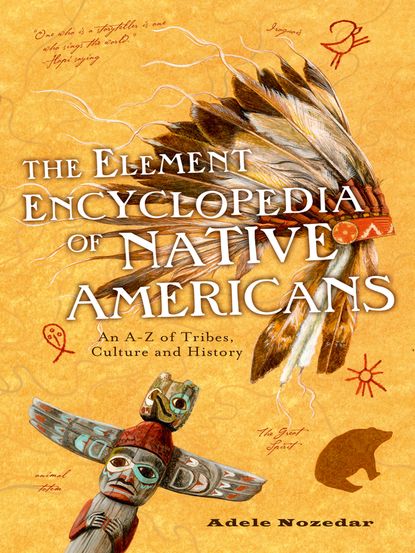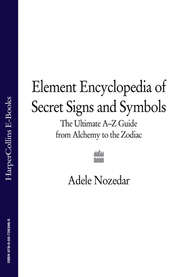По всем вопросам обращайтесь на: info@litportal.ru
(©) 2003-2024.
✖
The Element Encyclopedia of Native Americans: An A to Z of Tribes, Culture, and History
Настройки чтения
Размер шрифта
Высота строк
Поля
The Element Encyclopedia of Native Americans: An A to Z of Tribes, Culture, and History
Adele Nozedar
A comprehensive guide to the history, culture, and religious beliefs and practices of America’s native people, The Element Encyclopedia of Native Americans tells the varied and colourful stories of the tribes, their greatest leaders, wars, pacts, and the long-lasting impact that their profound wisdom and spirituality has on the West today.Containing a fascinating and comprehensive list of A-Z entries, including a series of essays, this encyclopedia will highlight:• Rituals and Ceremonies• Sacred Sites• The Arrival of the Europeans• Shamanism• Totems• The Warrior• The Afterlife• The First Nation Today• The Reservations• The Visionary World• Ancestors and SpiritsIllustrated throughout, including charts of the totem animals belonging to each clan and maps of tribal areas.
DEDICATION (#ulink_23680ee7-afbc-57fc-8c62-89d9bee09d56)
“That knowledge of past wrongs
will teach us to be wiser”
CONTENTS
Cover (#ud72122cc-7236-517a-a6f4-5203864a4ca7)
Title Page (#uc6111658-6e03-551f-92ce-cbc8426de3c4)
Dedication (#ulink_88184f52-e269-5321-aaae-03b0d59f4897)
Introduction (#ulink_c356efd0-ab95-5d63-846b-d0ce15112ec3)
Map (#u312b708d-b1fc-5bfd-9db6-68521f4a406e)
The Element Encyclopedia of Native Americans
A—Abenaki to Atlatl (#u4f5102d2-bc3c-5822-abf1-4e32c05fbee3)
B—Babiche to Bury the Hatchet (#ueeddc57a-2985-5a91-b75f-da21a0694084)
C—Cacique to Custer’s Last Stand (#u7e305992-022c-5e5f-a604-bb47956f79a1)
D—Dakota to Duwamish (#litres_trial_promo)
E—Eagles to Etching (#litres_trial_promo)
F—False Face to French and Indian War (#litres_trial_promo)
G—Gall to Guyasuta (#litres_trial_promo)
H—Hair to Huron (#litres_trial_promo)
I—Illinois to The Iroquois False Face Society (#litres_trial_promo)
J—James Bigheart to Jumping Bull (#litres_trial_promo)
K—Kachina to Kokopelli (#litres_trial_promo)
L—La Flesche, Susette to Luther Standing Bear (#litres_trial_promo)
M—Mahican to Mystery Dog (#litres_trial_promo)
N—Names for the White Man to Nisqually (#litres_trial_promo)
O—Oglala to Ouray (#litres_trial_promo)
P—Pacanne to Pushmataha (#litres_trial_promo)
Q—Quapaw to Quetzalcoatl (#litres_trial_promo)
R—Rain-in-the-Face to Roots (#litres_trial_promo)
S—Sacajawea to Syringes (#litres_trial_promo)
T—Tadodaho to Tuskaloosa (#litres_trial_promo)
U—Umiak to Ute (#litres_trial_promo)
V—Vanilla to Vision Quest (#litres_trial_promo)
W—Wabanaki Confederacy to Wyandot (#litres_trial_promo)
Y—Yakama to Yuchi (#litres_trial_promo)
Z—Zitkala-Sa to Zuni (#litres_trial_promo)
Picture Section (#litres_trial_promo)
Image credits (#litres_trial_promo)
Copyright page (#litres_trial_promo)
About the Publishers (#litres_trial_promo)
INTRODUCTION (#ulink_9deb02f9-12a8-5b3a-9a40-9c5744b8ee46)
“Though the treatment accorded the Indians by those who lay claim to civilization and Christianity has in many cases been worse than criminal, a rehearsal of these wrongs does not properly find a place here. Whenever it may be necessary to refer to some of the unfortunate relations that have existed between the Indians and the white race, it will be done in that unbiased manner becoming the student of history. As a body politic recognizing no individual ownership of lands, each Indian tribe naturally resented encroachment by another race, and found it impossible to relinquish without a struggle that which belonged to their people from time immemorial. On the other hand, the white man whose very own may have been killed or captured by a party of hostiles forced to the warpath by the machinations of some unscrupulous Government employee, can see nothing that is good in the Indian. There are thus two sides to the story, and in these volumes such questions must be treated with impartiality.”—Edward S. Curtis, 1907
The story of the indigenous peoples of North and South America is a harrowing one. Time after time, in reading accounts of what happened, we see the same sequence of events, which were wryly and concisely encapsulated in a cartoon seen on a popular social networking site: an image of a “typical” Native American with the caption, “Bet you wish you’d never fed those pilgrims.”
The striving for cultural superiority—and the many ways and means in which that superiority was demonstrated—has destroyed many lives, crushed cultures and belief systems, wrecked families, and smashed peace and equanimity to smithereens. And yet, ironically, what we perceive as the Native American way of life is something to which many aspire. The spirituality of the Native American way is not separate from “normal” life as it is for those of a Western mind-set. The innate respect for all of nature, and the consequences of that respect, are goals that have a practical as well as spiritual force and are within reach of everyone, no matter their culture.
Despite the many privations inflicted upon the Native Americans, their profoundly empathetic underlying nature is as strong as it ever was, and so the stories in this book should be absorbed in the context of us being aware of a history which affects everyone. And we should do our utmost to make sure these types of atrocity never happen again.
ABENAKI
This group, who were concentrated in what has become New Hampshire and Maine, are a part of the Algonquian people and were among the first of the Native peoples of North America that European settlers would have encountered. The coming of the white man’s diseases, along with the risk of annihilation by warring French and English factions, forced the tribe into Quebec in the later part of the 17th century.
The Abenaki people refer to themselves as Alnobak, which means “The Real People” or “men.” It was not uncommon among Native American nations to refer to themselves in this way. The origin of the word Abenaki is from Wabanaki, which translates as “People of the Dawn Lands,” a reference to their home in the east.
One Abenaki myth states that the god Kechi Niwaskw created the first man and the first woman from stone; however, Kechi Niwaskw wasn’t happy, destroyed his first attempt at sculpture, and instead carved his creation again from wood. The Abenaki believed that they were descended directly from these wooden figures.
Adele Nozedar
A comprehensive guide to the history, culture, and religious beliefs and practices of America’s native people, The Element Encyclopedia of Native Americans tells the varied and colourful stories of the tribes, their greatest leaders, wars, pacts, and the long-lasting impact that their profound wisdom and spirituality has on the West today.Containing a fascinating and comprehensive list of A-Z entries, including a series of essays, this encyclopedia will highlight:• Rituals and Ceremonies• Sacred Sites• The Arrival of the Europeans• Shamanism• Totems• The Warrior• The Afterlife• The First Nation Today• The Reservations• The Visionary World• Ancestors and SpiritsIllustrated throughout, including charts of the totem animals belonging to each clan and maps of tribal areas.
DEDICATION (#ulink_23680ee7-afbc-57fc-8c62-89d9bee09d56)
“That knowledge of past wrongs
will teach us to be wiser”
CONTENTS
Cover (#ud72122cc-7236-517a-a6f4-5203864a4ca7)
Title Page (#uc6111658-6e03-551f-92ce-cbc8426de3c4)
Dedication (#ulink_88184f52-e269-5321-aaae-03b0d59f4897)
Introduction (#ulink_c356efd0-ab95-5d63-846b-d0ce15112ec3)
Map (#u312b708d-b1fc-5bfd-9db6-68521f4a406e)
The Element Encyclopedia of Native Americans
A—Abenaki to Atlatl (#u4f5102d2-bc3c-5822-abf1-4e32c05fbee3)
B—Babiche to Bury the Hatchet (#ueeddc57a-2985-5a91-b75f-da21a0694084)
C—Cacique to Custer’s Last Stand (#u7e305992-022c-5e5f-a604-bb47956f79a1)
D—Dakota to Duwamish (#litres_trial_promo)
E—Eagles to Etching (#litres_trial_promo)
F—False Face to French and Indian War (#litres_trial_promo)
G—Gall to Guyasuta (#litres_trial_promo)
H—Hair to Huron (#litres_trial_promo)
I—Illinois to The Iroquois False Face Society (#litres_trial_promo)
J—James Bigheart to Jumping Bull (#litres_trial_promo)
K—Kachina to Kokopelli (#litres_trial_promo)
L—La Flesche, Susette to Luther Standing Bear (#litres_trial_promo)
M—Mahican to Mystery Dog (#litres_trial_promo)
N—Names for the White Man to Nisqually (#litres_trial_promo)
O—Oglala to Ouray (#litres_trial_promo)
P—Pacanne to Pushmataha (#litres_trial_promo)
Q—Quapaw to Quetzalcoatl (#litres_trial_promo)
R—Rain-in-the-Face to Roots (#litres_trial_promo)
S—Sacajawea to Syringes (#litres_trial_promo)
T—Tadodaho to Tuskaloosa (#litres_trial_promo)
U—Umiak to Ute (#litres_trial_promo)
V—Vanilla to Vision Quest (#litres_trial_promo)
W—Wabanaki Confederacy to Wyandot (#litres_trial_promo)
Y—Yakama to Yuchi (#litres_trial_promo)
Z—Zitkala-Sa to Zuni (#litres_trial_promo)
Picture Section (#litres_trial_promo)
Image credits (#litres_trial_promo)
Copyright page (#litres_trial_promo)
About the Publishers (#litres_trial_promo)
INTRODUCTION (#ulink_9deb02f9-12a8-5b3a-9a40-9c5744b8ee46)
“Though the treatment accorded the Indians by those who lay claim to civilization and Christianity has in many cases been worse than criminal, a rehearsal of these wrongs does not properly find a place here. Whenever it may be necessary to refer to some of the unfortunate relations that have existed between the Indians and the white race, it will be done in that unbiased manner becoming the student of history. As a body politic recognizing no individual ownership of lands, each Indian tribe naturally resented encroachment by another race, and found it impossible to relinquish without a struggle that which belonged to their people from time immemorial. On the other hand, the white man whose very own may have been killed or captured by a party of hostiles forced to the warpath by the machinations of some unscrupulous Government employee, can see nothing that is good in the Indian. There are thus two sides to the story, and in these volumes such questions must be treated with impartiality.”—Edward S. Curtis, 1907
The story of the indigenous peoples of North and South America is a harrowing one. Time after time, in reading accounts of what happened, we see the same sequence of events, which were wryly and concisely encapsulated in a cartoon seen on a popular social networking site: an image of a “typical” Native American with the caption, “Bet you wish you’d never fed those pilgrims.”
The striving for cultural superiority—and the many ways and means in which that superiority was demonstrated—has destroyed many lives, crushed cultures and belief systems, wrecked families, and smashed peace and equanimity to smithereens. And yet, ironically, what we perceive as the Native American way of life is something to which many aspire. The spirituality of the Native American way is not separate from “normal” life as it is for those of a Western mind-set. The innate respect for all of nature, and the consequences of that respect, are goals that have a practical as well as spiritual force and are within reach of everyone, no matter their culture.
Despite the many privations inflicted upon the Native Americans, their profoundly empathetic underlying nature is as strong as it ever was, and so the stories in this book should be absorbed in the context of us being aware of a history which affects everyone. And we should do our utmost to make sure these types of atrocity never happen again.
ABENAKI
This group, who were concentrated in what has become New Hampshire and Maine, are a part of the Algonquian people and were among the first of the Native peoples of North America that European settlers would have encountered. The coming of the white man’s diseases, along with the risk of annihilation by warring French and English factions, forced the tribe into Quebec in the later part of the 17th century.
The Abenaki people refer to themselves as Alnobak, which means “The Real People” or “men.” It was not uncommon among Native American nations to refer to themselves in this way. The origin of the word Abenaki is from Wabanaki, which translates as “People of the Dawn Lands,” a reference to their home in the east.
One Abenaki myth states that the god Kechi Niwaskw created the first man and the first woman from stone; however, Kechi Niwaskw wasn’t happy, destroyed his first attempt at sculpture, and instead carved his creation again from wood. The Abenaki believed that they were descended directly from these wooden figures.







